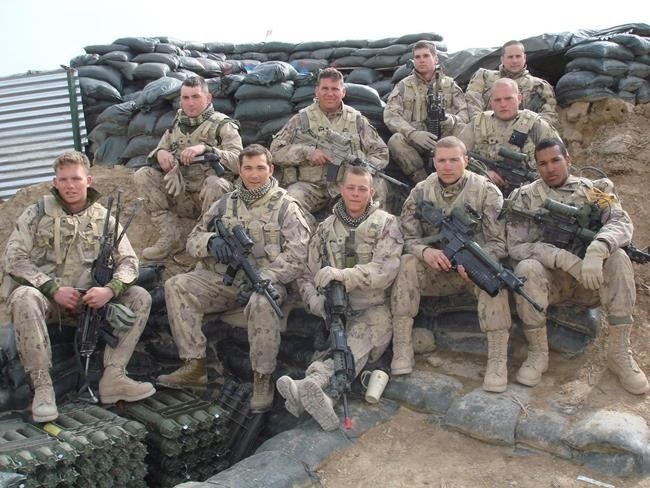
Lionel Desmond (front row, far right) was part of the 2nd battalion, of the Royal Canadian Regiment, based at CFB Gagetown and shown in this 2007 handout photo taken in Panjwai district in between patrol base Wilson and Masum Ghar in Afghanistan. An apparent murder-suicide involving a former soldier and his family has renewed calls to bolster support for those suffering from post-traumatic stress disorder. The body of 33-year-old Afghanistan veteran Lionel Desmond was found Tuesday in Upper Big Tracadie, N.S. RCMP say he appeared to have died from a self-inflicted gunshot wound. His wife Shanna Desmond, their 10-year-old daughter Aaliyah and his mother Brenda Desmond, 52, also died of apparent gunshot wounds.
Image Credit: THE CANADIAN PRESS/HO-Facebook-Trev Bungay
January 08, 2017 - 9:00 PM
A murder-suicide involving a former soldier and his family has renewed calls to bolster support for those suffering from post-traumatic stress disorder.
The body of 33-year-old Afghanistan veteran Lionel Desmond was found Tuesday in Upper Big Tracadie, N.S. Police say autopsies concluded Desmond and three family members died of gunshot wounds, and that his own wound was self-inflicted. Desmond's 31-year-old wife Shanna, their 10-year-old daughter Aaliyah and his 52-year-old mother Brenda Desmond were the victims.
Before the tragedy, Desmond revealed on social media that he was struggling with PTSD, as well as post-concussion disorder and "ADD/ADHD from thrashing my head."
But such extreme attacks by PTSD sufferers are relatively rare, says Dr. Raj Bhatla, psychiatrist-in-chief at The Royal, a mental health centre in Ottawa.
"Usually people have (caused) harm more towards themselves than to anyone else," says Bhatla, referencing a number of military suicides linked to PTSD.
Here's a look at the devastating toll of post-traumatic stress disorder:
WHAT IS IT?
According to the PTSD Association of Canada, the condition can develop after a traumatic event in which a person experiences extreme fear, helplessness, or horror. These events can include a sexual or physical assault, the unexpected death of a loved one, an accident, war, or natural disaster.
———
WHEN DID IT FIRST EMERGE?
Bhatla says the term "post-traumatic stress disorder" wasn't formalized until 1980, but references to frightening battle dreams date back to around 400 B.C.
The term "soldier's heart" was coined in the late 1800s while in 1905, the phrase "battle shock" emerged and was recognized as a legitimate medical condition by the Russian army. The First World War saw the first appearance of the term "shell shock," which morphed into "combat exhaustion" in the Second World War.
"It's always been the same thing, it just changes terminology," says Bhatla.
The condition got a higher profile when the Vietnam War led to "post-Vietnam syndrome." More recently, the Canadian Forces adopted the term Operational Stress Injury, or OSI, which includes other conditions related to deployment like major depression, anxiety-type illnesses and substance abuse.
———
WHAT ARE THE SYMPTOMS?
Symptoms can include a deep sense of helplessness, panic attacks, irritability, anger outbursts, problems at home or work, abnormal fear, feelings of devastation or numbness, flashbacks from the event, aversion to social contact, or avoidance of situations that might trigger memories of the event, says the PTSD Association of Canada.
"The symptoms aren't necessarily structured for every individual in the same manner," adds Greg Lubimiv of the Phoenix Centre for Children and Families near Garrison Petawawa.
"Twenty people might have different clusters so their PTSD is actually very unique to them."
———
HOW IS IT TRIGGERED?
The PTSD Association of Canada says trauma can be triggered by large-scale ordeals or any other life-altering experience. This can include terrorism attacks or devastating natural disasters, or highly personal events like a car accident, losing a job, divorce, failing to achieve a goal, seeing or hearing of a death, or personal injury.
But Lubimiv notes that small things can set off memories, too, such as a loud bang, the sound of a clock ticking, the colour red, or the smell of gas.
"That's what makes it more difficult in many ways around managing and trying to respond to the PTSD," says Lubimiv.
———
WHAT ARE THE LONG-TERM EFFECTS OF PTSD?
Lubimiv notes PTSD "interrupts the flow of your life."
"It interrupts you doing the things that you normally need to do or would like to do, like work, like have a relationship with your child, or go to the playground, or play an instrument or whatever that is.... It becomes a wall to regular life."
Left untreated, "the wall becomes higher and thicker."
But Bhatla stresses there is hope.
"PTSD, major depression, substance abuse — these are treatable conditions. For some individuals it's harder to treat than others, but very treatable. The important piece is also the earlier people get help for symptoms, the easier it is to treat."
News from © iNFOnews, 2017